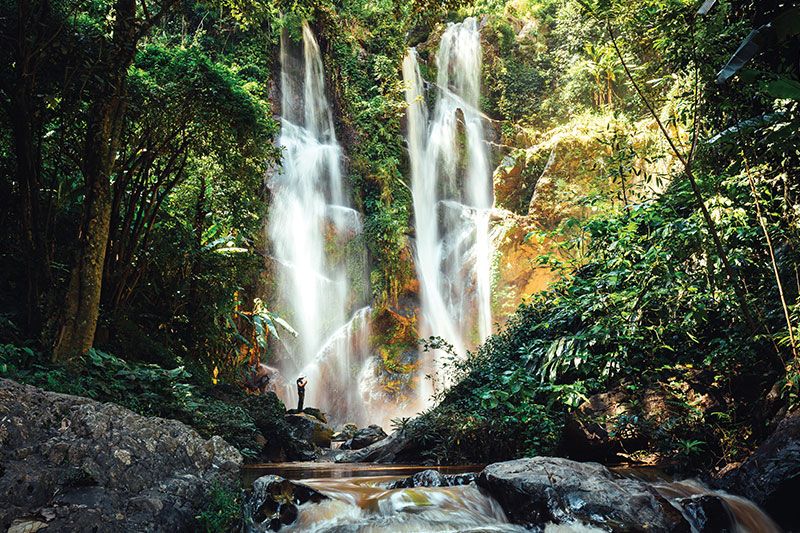
Wonderfalls
A glimpse at some of Thailand’s most wonderful waterfalls
Words: Ron Emmons
Photos: Ron Emmons & Shutterstock
What is it about waterfalls that makes them so attractive? Could it be the negative ions seeping into our brain and brightening our mood? Or perhaps it’s the invigorating sound of water splashing and gurgling downstream? Maybe it’s simply the sight of this supposedly transparent substance dancing in delightful patterns before our eyes? Whatever the reason, most of us enjoy an outing to a waterfall, of which there are plenty in Thailand. So, let’s take a look at some of these wonderfalls.
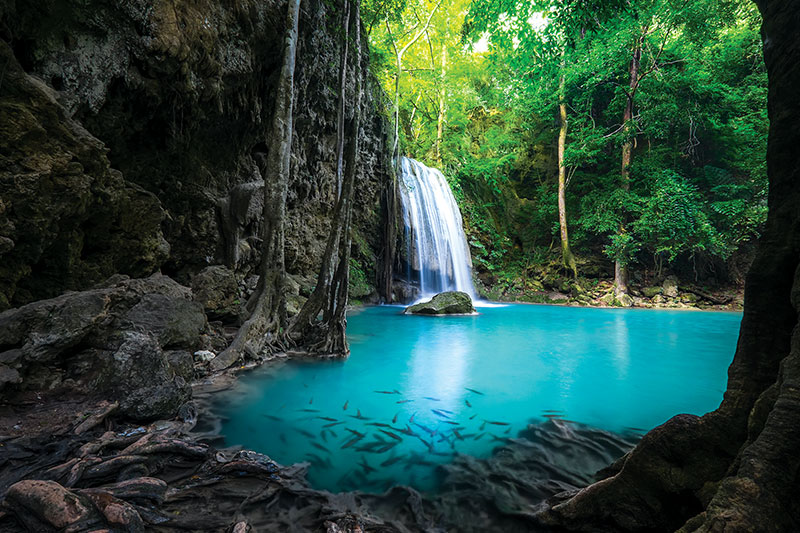
Famous Falls
At once Thailand’s most popular and arguably most beautiful waterfall is the seven-tiered Erawan Waterfall, located beyond Kanchanaburi in the west of the country. The water in the pools beneath each cataract is an astounding shade of turquoise, and shoals of fish are on hand to provide a natural fish spa for anyone taking a dip. The falls are named after the three-headed elephant of Hindu mythology, since the top level is formed by a triple cascade.
Less crowded but just as eye-catching as Erawan are the Mae Khamin Falls in the Srinagarindra Dam National Park, a short way northwest of Erawan. These falls also have seven levels, of which the fourth level, right beside the park headquarters, is the most dramatic. Mineral deposits create symmetrical ledges, giving the appearance of a liquid staircase.
Even more impressive than these, though difficult to access, is the Thi Lo Su Waterfall near the Myanmar border. After a long and winding drive to Umphang, passing the pretty, roadside Pha Charoen Falls, visitors continue to Thi Lo Su Falls by longtail boat, then a picturesque half-hour walk to reveal this multi-level wonder in the jungle, stretching over 200 metres high and 400 wide. After heavy rain, however, the falls create a mist that obscures the magical view.
For easier access to some of Thailand’s top falls, Doi Inthanon is the place to go. Beside the route to the summit of the country’s highest peak (2,565 metres), the Mae Klang, Wachiratharn and Siritharn Falls are all impressive, each with its own charm. However, dedicated waterfall aficionados should branch left at the foot of the mountain to Mae Ya Falls, which tumble over endless cataracts from a height of over 250 metres to make a picture-perfect sight.
Though the majority of the country’s waterfalls are in the mountainous north, Thailand’s islands also feature some splendid cascades. The Na Muang Falls on Koh Samui are a good example, with the upper level (Na Muang 2) worth the difficult hike to get there. Another island with good falls is Koh Kood, near the Cambodian border, where the Khlong Chao Waterfall plummets into a refreshing pool.
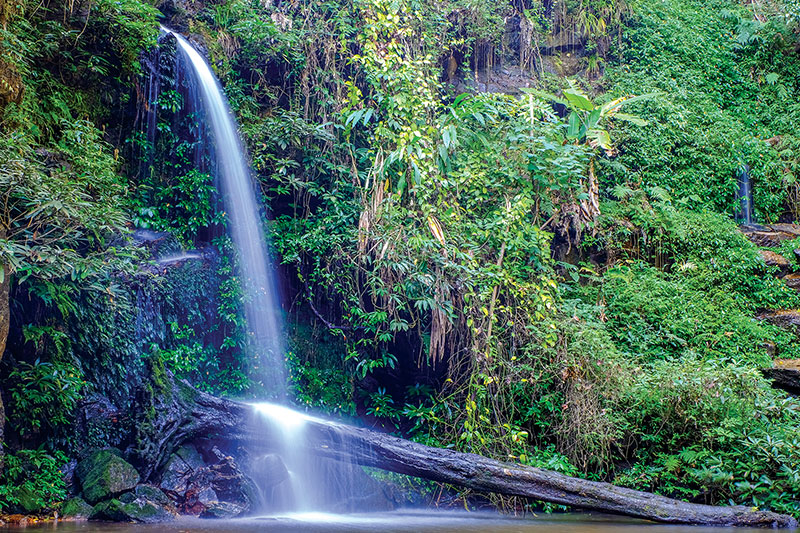
Fun Falls
Have you ever walked up or down a waterfall? If not, head for the Bua Thong Falls, better known as the Sticky Falls, near Chiang Mai, where the mineral deposits and a rope attached to a tree make this unusual experience possible, enabling feet to get a grip on the surface, and plenty of visitors are eager to take on the challenge.
Travellers renting a car or motorbike to get around should look out for waterfalls near the route of a journey that can offer a welcome break. One such example is Mok Fa Falls, just off the road between Chiang Mai and Pai. This fall may be little more than a metre wide, but it plunges around 60 metres into a pool ringed by a sandy beach, and if the flow is not too strong, it offers the chance to take an extremely tall shower.
A similarly cute, slender fall can be found just off the road leading up Doi Suthep from Chiang Mai. The Monthatharn Falls has several levels, and from the second level a chute of spray curls out and splashes onto a fallen tree trunk, almost begging to be rendered as a smooth arc in a photograph.
Many Thai falls have picnic tables conveniently located to enjoy the view and some have pools beneath them in which to splash around. However, avoid the temptation to go clambering over rocks for a better view as it’s easy to slip and fall. Better to sit and meditate on the soothing flow.
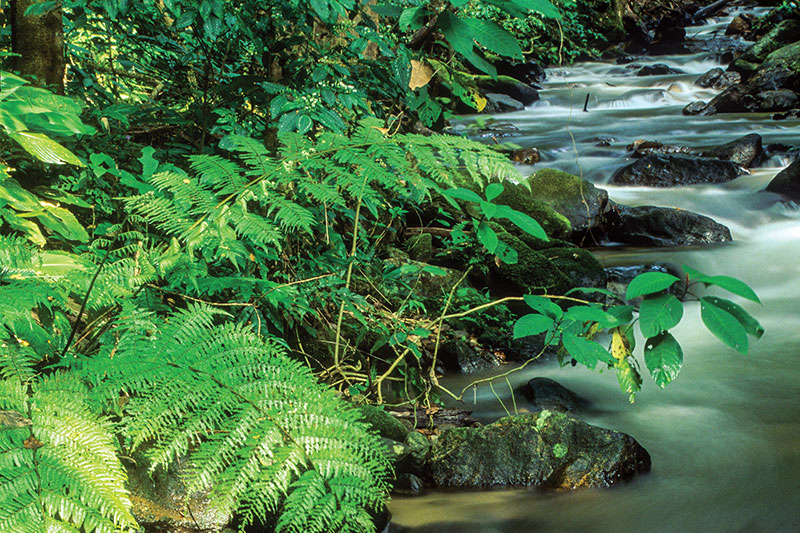
Abstract Falls
Besides presenting us with the pleasing spectacle of a stream of plummeting water boulders, waterfalls can also provide endless inspiration for creative photographers. Even a cascade of a few centimetres’ height can provide an abstract image of water. By playing around with different focal lengths and speed settings, we might chance upon scenes that are full of light and texture, and inspire in us a true sense of wonder.
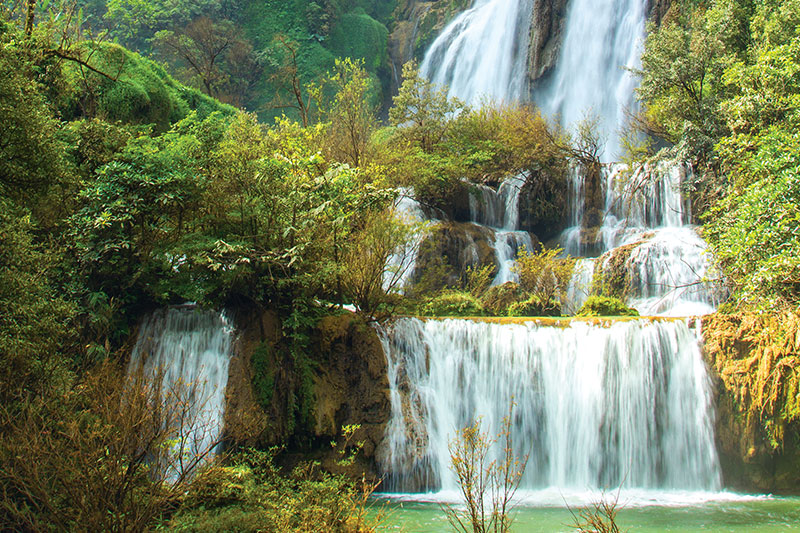
Visiting and Photographing Falls
Most of the falls mentioned here are located in national parks or wildlife reserves, so expect to pay 100-300 baht entry and a small parking fee. fortunately, because snacking is a national pastime in Thailand, there are food and drink stalls near to most of these waterfalls, providing welcome refreshment. Also, keep in mind the maxim “Take only photographs; leave only footprints”, and carry out plastic bottles and packaging with you.
The key to getting a silky-smooth shot of a waterfall, looking like a curtain of mist, is by using a long exposure, preferably a half or full second, and a small aperture (f16 or f22). These settings are difficult to achieve in bright light, so it’s better to shoot early or late in the day or when it’s overcast. Long exposures require the use of a tripod, which in turn helps with composition; when going to the effort of setting up a tripod, we have an extra incentive to get the composition right. Including people in such a shot can be a problem, however, as they rarely stay still, especially under a waterfall. So, if it’s a memento for a friend, ask them to stand still for a second.
